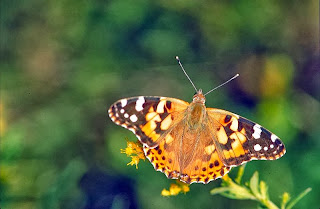How many other butterflies migrate?
The North American Butterfly Association has listed about a dozen butterflies that fly south in the fall and back north in the spring.
Which butterflies at Baltimore Woods migrate?
Of the butterflies that are seen at Baltimore Woods, the Question Mark, Mourning Cloak, Painted Lady, and Red Admiral all migrate south in the fall in addition to the Monarch. They may not fly as far as Mexico but they will still fly to the southern United States and will often migrate in very large numbers.
 |
| Question Mark Polygonia interrogationis |
 |
| Mourning Cloak Nymphalis antiopa |
 |
| Painted Lady Vanessa cardui |
 |
| Red Admiral Vanessa atalanta |
Baltimore Woods has a fantastic selection of nectar plants for these butterflies, especially near the log cabin. Take a walk on one of these warm fall days and see which butterflies you can find. Not much is known about the migration of other butterflies because they're not as heavily researched as Monarchs. What I do know is that I'm still seeing Mourning Cloaks and Clouded Sulphur butterflies around Baltimore Woods on the sunny days we've been having.
Where do butterflies go if they don't migrate?
Most butterflies do not overwinter as adults. Swallowtails, for example, can be found as pupae buried underground and will emerge as adults in the spring. For those butterflies that do withstand winter, they seek shelter and go into diapause.
Woolly Bear caterpillars
Woolly Bears are not butterflies (they are the Isabella Tiger Moth Psyrrharctia isabella), they are still one of those familiar fuzzy bodies that are often seen crossing roads and paths this time of year. At some point in your life (probably when you were young enough to believe it) you may have been told a legend that the larger the orange band on woolly bear caterpillars, the longer the coming winter will be and vice versa.
What the large orange band actually means is how close the caterpillar is to overwintering. The orange band grows with each molt so instead of getting worried about how you're going to survive another frigid winter, you can determine if the woolly bear is ready for winter or not, depending on the length of its band. They will freeze solid throughout winter, producing a cryoprotectant in their tissues so they can continue feeding in the spring. From there the life cycle moves quickly and the larva hatches from an egg again in the fall.
What butterflies and caterpillars have you seen this fall?
Blog post by Anna Leiss
What the large orange band actually means is how close the caterpillar is to overwintering. The orange band grows with each molt so instead of getting worried about how you're going to survive another frigid winter, you can determine if the woolly bear is ready for winter or not, depending on the length of its band. They will freeze solid throughout winter, producing a cryoprotectant in their tissues so they can continue feeding in the spring. From there the life cycle moves quickly and the larva hatches from an egg again in the fall.
What butterflies and caterpillars have you seen this fall?
Blog post by Anna Leiss


I have seen tons of Woolly Bears crossing the road.... We need a Woolly Bear crossing guard to make sure they make it safely across!
ReplyDelete